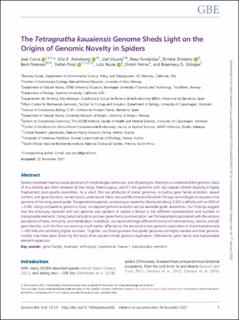The Tetragnatha kauaiensis Genome Sheds Light on the Origins of Genomic Novelty in Spiders
| dc.contributor.author | Cerca, José | |
| dc.contributor.author | Armstrong, Ellie E. | |
| dc.contributor.author | Vizueta, Joel | |
| dc.contributor.author | Fernández, Rosa | |
| dc.contributor.author | Dimitrov, Dimitar Stefanov | |
| dc.contributor.author | Petersen, Bent | |
| dc.contributor.author | Prost, Stefan | |
| dc.contributor.author | Rozas, Julio | |
| dc.contributor.author | Petrov, Dmitri | |
| dc.contributor.author | Gillespie, Rosemary G. | |
| dc.date.accessioned | 2022-01-19T12:41:33Z | |
| dc.date.available | 2022-01-19T12:41:33Z | |
| dc.date.created | 2022-01-17T14:26:11Z | |
| dc.date.issued | 2021 | |
| dc.identifier.citation | Genome Biology and Evolution. 2021, 13 (12), . | en_US |
| dc.identifier.issn | 1759-6653 | |
| dc.identifier.uri | https://hdl.handle.net/11250/2838267 | |
| dc.description.abstract | Spiders (Araneae) have a diverse spectrum of morphologies, behaviors, and physiologies. Attempts to understand the genomic-basis of this diversity are often hindered by their large, heterozygous, and AT-rich genomes with high repeat content resulting in highly fragmented, poor-quality assemblies. As a result, the key attributes of spider genomes, including gene family evolution, repeat content, and gene function, remain poorly understood. Here, we used Illumina and Dovetail Chicago technologies to sequence the genome of the long-jawed spider Tetragnatha kauaiensis, producing an assembly distributed along 3,925 scaffolds with an N50 of ∼2 Mb. Using comparative genomics tools, we explore genome evolution across available spider assemblies. Our findings suggest that the previously reported and vast genome size variation in spiders is linked to the different representation and number of transposable elements. Using statistical tools to uncover gene-family level evolution, we find expansions associated with the sensory perception of taste, immunity, and metabolism. In addition, we report strikingly different histories of chemosensory, venom, and silk gene families, with the first two evolving much earlier, affected by the ancestral whole genome duplication in Arachnopulmonata (∼450 Ma) and exhibiting higher numbers. Together, our findings reveal that spider genomes are highly variable and that genomic novelty may have been driven by the burst of an ancient whole genome duplication, followed by gene family and transposable element expansion. | en_US |
| dc.language.iso | eng | en_US |
| dc.publisher | Oxford University Press on behalf of the Society for Molecular Biology and Evolution. | en_US |
| dc.rights | Navngivelse 4.0 Internasjonal | * |
| dc.rights.uri | http://creativecommons.org/licenses/by/4.0/deed.no | * |
| dc.title | The Tetragnatha kauaiensis Genome Sheds Light on the Origins of Genomic Novelty in Spiders | en_US |
| dc.type | Peer reviewed | en_US |
| dc.type | Journal article | en_US |
| dc.description.version | publishedVersion | en_US |
| dc.rights.holder | © The Author(s) 2021. | en_US |
| dc.source.volume | 13 | en_US |
| dc.source.journal | Genome Biology and Evolution (GBE) | en_US |
| dc.source.issue | 12 | en_US |
| dc.identifier.doi | 10.1093/gbe/evab262 | |
| dc.identifier.cristin | 1982700 | |
| cristin.ispublished | true | |
| cristin.fulltext | original | |
| cristin.qualitycode | 2 |
Tilhørende fil(er)
Denne innførselen finnes i følgende samling(er)
-
Institutt for naturhistorie [1213]
-
Publikasjoner fra CRIStin - NTNU [37186]

